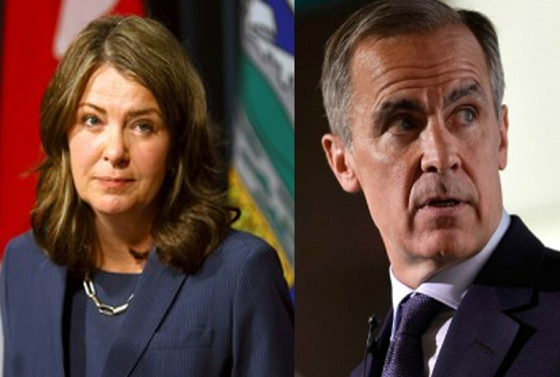National
Red Deer – Lacombe MP Blaine Calkins calls on Prime Minister Justin Trudeau to resign

What We Know About Trudeau’s Latest Ethics Scandal
BLAINE CALKINS
Over the past several weeks Canadians have been shocked at the details coming to light regarding Justin Trudeau’s WE Scandal. Justin Trudeau and the Kielburgers have been happy to benefit from each other for years. While they are quick to downplay their relationship, the facts tell a different story. According to WE Charity, Justin Trudeau and his family have participated in over 50 WE Events where they have been able to share their political message with young Canadians.
In 2017 WE created a campaign style ad featuring Justin Trudeau for Canada 150 and even pressured employees to go to a political event for the Minister of Finance in his Toronto riding. The Kielburger brothers have donated to the Liberal Party in the past, and under the Trudeau government WE has received upwards of $5.5 million in government funding.
This reciprocal relationship is concerning all on its own, before even considering the current scandal regarding the Canada Student Service Grant, Justin Trudeau and WE. The twists and turns in the story can be difficult to track, but it is clear that Justin Trudeau and former Finance Minister Bill Morneau have once again failed to live up to their legal obligations laid out in Canada’s conflict of interest laws. Here is what we know so far.
In April, WE sent an unsolicited proposal for a youth entrepreneurship program to Minister Chagger and Minister Ng. Ten days later WE received a call from Rachel Wernick, a senior bureaucrat with Employment and Social Development Canada (ESDC) about the yet to be announced Canada Student Service Grant (CSSG). When the program was announced to the public a few days later WE co-founder Craig Kielburger sent Ms. Wernick a proposal to administer the grant that same day.
According to the Kielburgers someone at the Prime Minister’s Office (PMO) contacted them the next day about delivering the program, which they later recanted claiming it was a public servant who contacted them. Ms. Wernick is credited as being the public servant who recommended that WE was the only organization that could deliver the program.
On June 25th WE Charity was announced as the partner for the $900 million CSSG program, and Canadians were told they would receive $19.5 million to administer it. When asked, Trudeau suggested there was no conflict of interest because he and his wife had never been paid by the organization. A few days later Conservatives asked the Auditor General to probe the deal since parliamentary oversight was hindered by the program being outsourced, and due to concern over the well documented relationship between Trudeau and the Kielburgers.
By July 3rd Mark and Craig Kielburger announced that WE would be giving up the contract to administer the CSSG. On the same day, the Ethics Commissioner confirmed that he would be starting an investigation into Justin Trudeau for the third time. Less than a week later WE confirmed that the Prime Minister’s Mother, Margaret Trudeau had been paid $312,000 for 28 appearances since 2016 and that his brother, Alexandre Trudeau, was paid $40,000 for 8 events in 2017-2018. They also acknowledged that the Prime Minister’s wife, Sophie Gregoire Trudeau had received $1,400 for an appearance in 2012.
We later found out that on top of those fees WE Charity also paid an additional $212,846 in expenses between the three members of the Trudeau family. This brings the total remuneration to over $566,000. This revelation, in part, led to the Conservatives writing to the Commissioner of the RCMP to request that they look into this matter as it pertains to potential criminal code violations.
The Prime Minister isn’t the only one with an apparent conflict of interest in this matter, with former Minister Morneau also having close family ties with WE. Like the Prime Minister, he did not recuse himself despite the fact that his one daughter works for WE and another has been a speaker in the past and received a book endorsement. This led to the Ethics Commissioner launching an investigation into former Minister Morneau as well.
At an appearance before the Finance Committee former Minister Morneau would later go on to acknowledge that he and his wife had recently made two large donations, roughly $50,0000 each, and that he had also just written a cheque for over $41,000 to reimburse WE for expenses he and his family incurred on two vacations to Africa and South America, where they visited WE projects. WE later confirmed that the complementary trip was offered to former Minister Morneau and his family because of their history of significant donations to similar programs. These revelations led to the Conservative caucus calling for the now former Minister to resign.
The Finance Committee and the Ethics Committee began to look into this latest scandal, and the testimony and information they have received has painted a confusing and troubling picture. They uncovered a number of very concerning details before the Prime Minister prorogued Parliament in order to shut down the committees.
· WE stood to collect $45.53 million in fees, over double what was initially stated.
· The program, originally announced at over $900 million, was actually contracted out at $544 million instead. Why the discrepancy?
· The Clerk of the Privy Council stated that there were no red flags when considering WE, but that the Public Service didn’t probe the organizations finances. This is quite odd.
· The President of the Public Service Alliance disputed that only WE could have delivered the CSSG, stating that to say the Public Service was unable to was insulting. He pointed to the various government grant programs, Canada Summer Jobs and the Canada Service Corps as comparable programs. The theory that only WE could handle the program was further dismantled when it turned out that they had to subcontract part of the program because they weren’t able to deliver it in French.
· The contract for the CSSG wasn’t actually with WE Charity, but with WE Charity Foundation, a shell foundation that had no previous experience in delivering these types of programs.
· The former Chair of the Board at WE Charity testified that she had been forced to resign by Craig Kielburger for requesting financial documents from WE Executives to justify the layoff of hundreds of employees.
· The Kielburger brothers testified, claiming that they were running the program as a favour to Canada, and that their organization was to be reimbursed for expenses, but not make money off of the program. In a leaked document, a draft budget dated May 4th outlined some expenses including for staff salary. This included 175 program managers at $30,0000 each for 4.5 months work, ten supervisors at $45,000 each for 5.5months work, five group leaders at $70,000 each for 6 months work, and two project leaders for $125,000 for eight months work.
· WE Charity started to incur eligible expenses on May 5th, despite Cabinet not approving the program until May 22nd. This was being done with the full knowledge of ESDC, and allegedly at the financial liability of WE.
· Trudeau testified that he only found out about WE’s involvement on May 8th, shortly before it was set to be discussed at Cabinet. He claims that he removed it from the agenda and asked the public service to complete additional due diligence given his family connection to WE. He did not contact the Ethics Commissioner despite the concerns. This additional due diligence did not unearth any of the problems disclosed by the former Chair of the Board. It is noteworthy that no Minister, prior to the Prime Minister making his claim, had a story that would corroborate this feeble explanation.
The Prime Minister’s Chief of Staff confirmed that a handful of employees in PMO were aware of WE’s involvement and had interactions with the organization in the lead up to the approval. This included an interaction on May 5th, the day WE started incurring eligible expenses. So far, every time someone has come forward to try and explain away the Liberal’s latest mess, Canadians are left with more questions than when they started. Canadians deserve answers, and my Conservative colleagues and I are committed to finding them using every tool at our disposal.
While the studies at committee may have been temporarily halted by Trudeau’s prorogation Conservatives will continue to investigate this matter, and pursue every whiff of corruption like when we called on the Elections Commissioner to look into the political benefits that the Liberals have been given by WE. While the Prime Minister may be attempting to prevent Canadians from knowing the truth, Members of the Finance committee received thousands of heavily redacted documents from the Liberal government on the same day that Trudeau prorogued Parliament. They paint a very different picture of how WE came to be selected for this program than the one that the Liberals have offered up.
These documents suggest that the Minister of Diversity and Inclusion and Youth told WE to develop a proposal for a summer service opportunity before the CSSG was even announced. They go on to claim that the former Minister of Finance was “besties” with WE and that senior members of the Prime Minister’s office were involved in the development of the program and were having conversations with WE from an early stage. You can see these documents for yourself at wedocuments.ca.
The timeline of Mr. Trudeau’s version of events simply doesn’t add up. The CSSG was announced on April 22nd. A member of PMO spoke with WE about their proposal on May 5th, the same day they started to charge expenses for administering the program, but Cabinet wouldn’t approve the program for two and a half weeks.
Why was a charity that had to recently lay off hundreds of employees due to financial hardship related to COVID-19 so willing to accept the liability of starting the program without approval? Why were they so sure they would be approved? Why were they told they could start charging expenses before approval?
To answer that, you only need to look at the cozy relationship between Justin Trudeau, former Minister of Finance, Bill Morneau, the Liberal Party and WE. Now that the former Minister Bill Morneau has resigned and more than 5000 pages of documents have been released for review, Canadians are hungrier for that truth than ever before. The Liberals are banking on Canadians forgetting about this scandal during their prorogation and hoping that they can change the channel later this month with a new Throne Speech, but it isn’t going to work. Despite prorogation and all of the confusion and misdirection, one thing is absolutely clear – Justin Trudeau must resign for his part in this scandal.
Censorship Industrial Complex
Justice Centre campaigning Canadian provinces to follow Alberta’s lead protecting professionals

Justice Centre launches national campaign to stop ideological overreach in regulated professions
The Justice Centre for Constitutional Freedoms announces the launch of a national campaign urging all provinces to adopt legislation that restores professional regulators to their proper role of overseeing competence and ethics, rather than compelling speech or imposing political ideology on regulated professionals who serve the public.
Across Canada, professionals such as doctors, nurses, teachers, social workers, engineers, dentists, lawyers and many others are governed by regulatory bodies created to uphold technical competence and ethical standards. Instead of focusing on those core responsibilities, however, many regulators have begun embedding political or ideological content into mandatory courses, codes of ethics and continuing education requirements.
At the same time, professionals are increasingly being investigated or disciplined not for misconduct, but for expressing personal views or declining to endorse political positions.
To help Canadians take action, the Justice Centre has created an online tool with a ready-to-send letter that goes directly to the provincial representatives responsible for the relevant legislation. All the user needs to do is select their province and enter their information, and the tool automatically delivers the letter to the appropriate recipient.
The prepared letter outlines three essential legislative amendments:
- prohibiting regulatory bodies from pursuing political objectives;
- prohibiting regulators from monitoring or controlling the speech of their members; and
- prohibiting regulators from embedding political or ideological content into definitions of competence and ethics.
Alberta is the first province to take meaningful steps toward addressing this growing problem. Its proposed legislation, called the Regulated Professions Amendment Act, is designed to prevent regulators from compelling speech, advancing political objectives or embedding ideology into definitions of competence and ethics.
The Justice Centre encourages all Canadians to visit our website today to take action and help protect the independence of regulated professionals.
Bruce Dowbiggin
Integration Or Indignation: Whose Strategy Worked Best Against Trump?

““He knows nothing; and he thinks he knows everything. That points clearly to a political career.” George Bernard Shaw
In the days immediately following Donald Trump’s rude intervention into the 2025 Canadian federal election— suggesting Canada might best choose American statehood— two schools of thought emerged.
The first and most impactful school in the short term was the fainting-goat response of Canadian’s elites. Sensing an opening in which to erode Pierre Poilievre’s massive lead in the 2024 polls over Justin Trudeau, the Laurentian elite concocted Elbows Up, a self-pity response long on hurt feelings and short on addressing the issues Trump had cited in his trashing of the Canadian nation state.
In short order they fired Trudeau into oblivion, imported career banker Mark Carney as their new leader in a sham convention and convinced Canada’s Boomers that Trump had the tanks ready to go into Saskatchewan at a moment’s notice. The Elbows Up meme— citing Gordie Howe— clinched the group pout.

(In fact, Trump has said that America is the world’s greatest market, and if those who’ve used it for free in the past [Canada] want to keep special access they need to pay tariffs to the U.S. or drop protectionist charges on dairy and more against the U.S.)
The ruse worked out better than they could have ever imagined with Trump even saying he preferred to negotiate with Carney over Poilievre. In short order the Tories were shoved aside, the NDP kneecapped and the pet media anointed Carney the genius skewing Canada away from its largest trade partner to the Eurosphere. We remain in that bubble, although the fulsome promises of Carney’s first days are now coming due.
Which brings us to the second reaction. That was Alberta premier Danielle Smith bolting to Mar A Lago in the days following Trump’s comments. Her goal was to put pride aside and accept that a new world order was in play for Canada. She met with U.S. officials and, briefly, with Trump to remind them that Canada’s energy industry was integral to American prosperity and Canadian stability.
Needless to say, the fainting goats pitched a fit that not everyone was clutching pearls and rending garments in the wake of Trump’s dismissive assessment of his northern neighbours. Their solution to Trump was to join China in retaliatory tariffs— the only two nations to do so— and to boycott American products and travel. Like the ascetic monks they cut themselves off from real life. Trump has yet to get back to Carney the Magnificent

And Smith? She was a “traitor” or a “subversive” who should be keel hauled in the North Saskatchewan. For much of the intervening months she has been attacked at home in Alberta by the N-Deeps and in Ottawa by just about everyone on CBC, CTV, Global and the Globe & Mail. “How could she meet with the Cheeto?”
Nonetheless conservatives in the province moved toward a more independence within Canada. Smith articulated her demands for Alberta to prevent a referendum on whether to remain within Confederation. At the top of her list were pipelines and access to tidewater. Ergo, a no-go for BC’s squish premier David Eby who is the process of handing over his province to First Nations.
It became obvious that for all of Carney’s alleged diplomacy in Europe and Asia (is the man ever home?) he had a brewing disaster in the West with Alberta and Saskatchewan growing restless. In a striking move against the status quo, Nutrien announced it would ship its potash to tidewater via the U.S., thereby bypassing Vancouver’s strike-prone, outdated port and denying them billions.

Suddenly, Smith’s business approach began making eminent good sense if the goal is to keep Canada as one. So we saw last week’s “memorandum of understanding” between Alberta and Ottawa trading off carbon capture and carbon taxes for potential pipelines to tidewater on the B.C. coast. A little bit of something for everyone and a surrender on other things.
The most amazing feature of the Mark Carney/Danielle Smith MOU is that both politicians probably need the deal to fail. Carney can tell fossil-fuel enemy Quebec that he tried to reason with Smith, and Smith can say she tried to meet the federalists halfway. Failure suits their larger purposes. Which is for Carney to fold Canada into Euro climate insanity and Smith into a strong leverage against the pro-Canada petitioners in her province.
Soon enough, at the AFN Special Chiefs Assembly, FN Chief Cindy Woodhouse Nepinak told Carney that “Turtle Island” (the FN term for North America popularized by white hippy poet Gary Snyder) belongs to the FN people “from coast to coast to coast.” The pusillanimous Eby quickly piped up about tanker bans and the sanctity of B.C. waters etc.
Others pointed out the massive flaw in a plan to attract private interests to build a vital bitumen pipeline if the tankers it fills are not allowed to sail through the Dixon Entrance to get to Asia.
But then Eby got Nutrien’s message that his power-sharing with the indigenous might cause other provinces to bypass B.C. (imagine California telling Texas it can’t ship through its ports over moral objections to a product). He’s now saying he’s open to pipelines but not to lift the tanker ban along the coast. Whatever.
Meanwhile the kookaburras of isolation back east continue with virtue signalling on American booze— N.S. to sell off its remains stocks — while dreaming that Trump’s departure will lead to the good-old days of reliance on America’s generosity.
But Smith looks to be wining the race. B.C.’s population shrank 0.04 percent in the second quarter of 2025, the only jurisdiction in Canada to do so. Meanwhile, Alberta is heading toward five million people, with interprovincial migrants making up 21 percent of its growth.
But what did you expect from the Carney/ Eby Tantrum Tandem? They keep selling fear in place of GDP. As GBS observed, “You have learnt something. That always feels at first as if you have lost something.”
Bruce Dowbiggin @dowbboy is the editor of Not The Public Broadcaster A two-time winner of the Gemini Award as Canada’s top television sports broadcaster, his new book Deal With It: The Trades That Stunned The NHL And Changed hockey is now available on Amazon. Inexact Science: The Six Most Compelling Draft Years In NHL History, his previous book with his son Evan, was voted the seventh-best professional hockey book of all time by bookauthority.org . His 2004 book Money Players was voted sixth best on the same list, and is available via brucedowbigginbooks.ca.
-

 Alberta2 days ago
Alberta2 days agoAlberta will defend law-abiding gun owners who defend themselves
-

 Alberta2 days ago
Alberta2 days agoThis new Canada–Alberta pipeline agreement will cost you more than you think
-

 MAiD1 day ago
MAiD1 day agoFrom Exception to Routine. Why Canada’s State-Assisted Suicide Regime Demands a Human-Rights Review
-

 Business2 days ago
Business2 days agoNew Chevy ad celebrates marriage, raising children
-

 MAiD2 days ago
MAiD2 days agoHealth Canada report finds euthanasia now accounts for over 5% of deaths nationwide
-

 Automotive2 days ago
Automotive2 days agoPower Struggle: Governments start quietly backing away from EV mandates
-

 Business1 day ago
Business1 day agoCarney government should privatize airports—then open airline industry to competition
-

 Great Reset2 days ago
Great Reset2 days agoCanada’s MAiD (State Sanctioned Murder) Report Just Dropped






